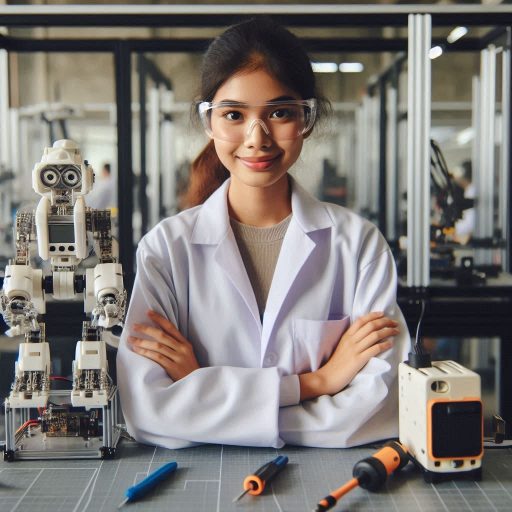Introduction
Robotics engineering is a field dedicated to designing, building, and programming robots.
It combines mechanical, electrical, and software engineering to create machines capable of performing tasks autonomously or semi-autonomously.
This interdisciplinary approach drives innovation across various industries, from manufacturing to healthcare.
Environmental sustainability is a critical concern that focuses on minimizing human impact on the environment.
Its goals include conserving natural resources, reducing waste, and protecting ecosystems to ensure the health and stability of our planet for future generations.
Sustainable practices are essential to addressing challenges like climate change, resource depletion, and pollution.
Robotics engineering and environmental sustainability are closely connected.
Robotics can significantly contribute to sustainability efforts by enhancing efficiency in various sectors.
For instance, robots can optimize processes in agriculture, leading to reduced use of water, fertilizers, and pesticides.
Robotics also revolutionizes waste management.
Automated systems streamline recycling processes, improve sorting accuracy, and increase the efficiency of waste handling.
The Role of Robotics Engineering in Sustainable Practices
Optimizing Processes with Robotics
Robotics engineering plays a significant role in advancing environmental sustainability.
Robotics can optimize processes in various industries to reduce waste and energy consumption.
Automation systems streamline manufacturing, minimize human error, and improve efficiency.
These systems can perform repetitive tasks more accurately and faster than humans.
By automating processes, companies can achieve higher productivity with lower resource usage.
Examples of Robotics in Environmental Sustainability
Several examples illustrate how robotics technology contributes to environmental sustainability:
- Waste Management: Robots sort recyclable materials with precision, reducing contamination and increasing recycling rates.
Automated systems can handle large volumes of waste efficiently, ensuring that more materials are properly recycled. - Agriculture: Robotics enhance sustainable farming practices.
Drones and autonomous tractors can monitor crops, apply precise amounts of water and fertilizers, and reduce the need for harmful chemicals. - Energy Efficiency: Robots are employed in energy sectors to inspect and maintain renewable energy infrastructure, such as wind turbines and solar panels.
- Pollution Control: Robots assist in environmental monitoring and pollution control.
For example, underwater robots track pollutants in water bodies, enabling timely responses to contamination and ensuring cleaner water sources.
Benefits of Using Robotics in Sustainable Practices
Integrating robotics into sustainable practices offers numerous benefits:
- Increased Efficiency: Robots streamline processes, reduce waste, and optimize resource usage.
Their precision and consistency improve overall operational efficiency. - Enhanced Safety: Automation reduces the need for human intervention in hazardous environments.
This minimizes risks and ensures safer working conditions. - Cost Savings: Robots lower operational costs by reducing labor expenses and improving productivity.
They also minimize waste and energy consumption, leading to long-term savings. - Environmental Impact: Robotics technology helps reduce the environmental footprint of industrial activities.
By optimizing processes and enhancing resource management, robots contribute to more sustainable practices. - Scalability: Robotics solutions are scalable, allowing industries to expand their sustainable practices as needed.
Automation systems can be adapted to different scales and applications.
Most importantly, robotics engineering significantly enhances environmental sustainability through process optimization and innovative applications.
The integration of robotics in various sectors leads to more efficient, safer, and environmentally friendly practices.
As technology continues to advance, the role of robotics in promoting sustainability will only grow, driving further improvements in resource management and environmental protection.
Read: Top Companies Hiring CAD Technicians in the USA
Impact of Robotics Engineering on Reducing Waste
Robotics in Waste Management and Recycling
Robotics engineering plays a crucial role in enhancing waste management and recycling processes.
Automated systems can sort, process, and manage waste more efficiently than traditional methods.
Robotics helps streamline recycling by separating materials with precision and speed, reducing the need for manual labor and minimizing human error.
Efficiency Improvements with Robotics
Robotics improves efficiency in waste reduction through several key advancements:
- Automated Sorting: Robots equipped with sensors and machine learning algorithms can identify and sort recyclable materials from waste streams.
This leads to higher purity of recycled materials and reduces contamination. - Increased Speed: Robotic systems operate at speeds far surpassing human capabilities.
This results in faster processing of waste and recycling materials, enhancing overall throughput. - Reduced Labor Costs: By automating repetitive and dangerous tasks, robotics decreases the need for manual labor in waste management facilities.
This not only cuts costs but also improves workplace safety. - Consistent Quality: Robots maintain consistent performance and quality in waste sorting and processing.
This ensures that recycling operations are reliable and efficient, leading to better recycling rates.
Case Studies of Successful Waste Reduction Initiatives
Several successful case studies highlight the effectiveness of robotics in waste reduction:
- ZenRobotics: This Finnish company has developed robotic systems that use artificial intelligence for sorting construction and demolition waste.
- AMP Robotics: Their robots use computer vision and machine learning to sort recyclable materials from waste streams, leading to higher efficiency and reduced contamination rates.
- The Waste Robotics Project: The robots assist in sorting and processing various types of waste, including plastics, metals, and paper, contributing to significant waste reduction and improved recycling efficiency.
- BHS Robotics: The BHS (Bulk Handling Systems) developed a robotic system for sorting and processing single-stream recyclables.
Their robots have increased processing speed and sorting accuracy, leading to a notable reduction in waste and higher recovery of recyclable materials.
Therefore, robotics engineering has a profound impact on reducing waste through enhanced efficiency and improved recycling processes.
By automating waste management tasks, robotics not only improves the accuracy and speed of waste sorting but also contributes to significant environmental benefits.
These advancements in robotics are paving the way for a more sustainable future by minimizing waste and maximizing recycling efforts.
Read: Best Online Courses for CAD Technician Training
Robotics Engineering in Renewable Energy Solutions
Role of Robotics in Renewable Energy
Robotics plays a pivotal role in advancing renewable energy solutions.
Robotics technology is used in developing and maintaining renewable energy sources such as wind, solar, and hydropower.
These automated systems enhance efficiency, safety, and reliability in renewable energy projects.
Advantages of Robotics in Renewable Energy
Robotics brings several advantages to renewable energy projects:
- Increased Efficiency: Robots can perform repetitive tasks faster and more accurately than humans.
This speeds up the installation and maintenance of renewable energy systems. - Enhanced Safety: Working in hazardous environments, like high-altitude wind turbines or underwater turbines, is safer with robots.
They reduce human exposure to dangerous conditions. - Cost Reduction: Automation lowers labor costs and minimizes human error.
Robots can work around the clock, which improves productivity and reduces long-term costs. - Precision and Accuracy: Robotics technology ensures precise measurements and operations, which enhances the performance and longevity of renewable energy systems.
- Remote Operation: Robots can be controlled remotely, allowing for inspection and maintenance of hard-to-reach or dangerous areas without endangering human workers.
Examples of Robotics Enhancing Renewable Energy
Several robotics technologies have significantly improved renewable energy sustainability:
- Wind Turbine Maintenance: Drones equipped with cameras and sensors inspect wind turbine blades for damage.
They provide real-time data and reduce the need for expensive, manual inspections. - Solar Panel Cleaning: Automated cleaning robots remove dust and debris from solar panels.
This process ensures maximum efficiency and prolongs the lifespan of the panels. - Underwater Inspection: Autonomous underwater vehicles (AUVs) inspect and maintain underwater turbines in hydropower systems.
They can perform detailed inspections without requiring divers. - Robotic Assembly: Robots are used in the assembly of solar panels and wind turbine components.
They handle heavy materials and complex tasks with high precision. - Predictive Maintenance: AI-powered robots predict equipment failures before they occur.
This helps in scheduling maintenance tasks proactively and avoiding costly downtime.
By integrating robotics into renewable energy projects, we can enhance sustainability and efficiency.
Robotics technology not only improves the performance of renewable energy systems but also contributes to their long-term viability.
These advancements support the global transition to cleaner energy sources and drive progress towards environmental sustainability.
Read: How to Build a Strong CAD Technician Portfolio

Challenges and Limitations of Robotics Engineering in Environmental Sustainability
Hurdles in Implementing Robotics for Sustainable Practices
Robotics engineering offers great potential for environmental sustainability, yet it faces several challenges.
One major hurdle is high implementation costs.
Advanced robotics systems require significant investment, making them inaccessible for some organizations.
Another challenge is the complexity of integrating robots into existing environmental management systems.
Robots must work seamlessly with current technologies, which can be difficult to achieve.
Additionally, there is a lack of standardized protocols for using robotics in environmental applications.
Without universal guidelines, it‘s challenging to ensure consistency and effectiveness.
Furthermore, there are concerns about the environmental impact of producing and disposing of robotics.
The energy and resources required for manufacturing robots can offset their sustainability benefits if not managed properly.
Limitations of Current Robotics Technology
Current robotics technology has limitations that hinder its effectiveness in addressing environmental issues.
One limitation is the limited operational scope of many robots.
Many robots are designed for specific tasks and lack the flexibility to handle diverse environmental challenges.
Additionally, the current sensors and data processing capabilities of robots may not be advanced enough to detect and respond to environmental changes accurately.
Robots also face challenges in working in harsh or unpredictable environments.
For example, robots deployed in remote or extreme conditions might struggle with durability and reliability.
Another limitation is the energy consumption of robotic systems.
While robots can enhance efficiency, their energy use can sometimes negate the environmental benefits if not optimize
Strategies for Overcoming Challenges
To overcome these challenges, several strategies can be employed.
First, increasing collaboration between engineers, environmental scientists, and policymakers can lead to more effective robotics solutions.
This interdisciplinary approach helps in creating robots that are better suited for environmental applications.
Second, investing in research and development is crucial.
By advancing robotics technology, we can improve flexibility, sensor accuracy, and energy efficiency.
Innovations in these areas can make robots more adaptable and effective in diverse environmental contexts.
Third, developing and adhering to standardized protocols can enhance the consistency and reliability of robotics systems.
Creating guidelines for implementation and operation ensures that robots meet environmental sustainability goals.
Lastly, promoting sustainable practices in the manufacturing and disposal of robots is essential.
Using eco-friendly materials and energy-efficient processes reduces the overall environmental impact of robotics.
By addressing these challenges and limitations, robotics engineering can make significant strides in supporting environmental sustainability.
With continued innovation and collaboration, robots can become powerful tools in creating a more sustainable future.
Read: Future of CAD Technician Jobs in Engineering
Transform Your Career Today
Unlock a personalized career strategy that drives real results. Get tailored advice and a roadmap designed just for you.
Start NowInnovations in Robotics Engineering for Environmental Conservation
Recent Advancements in Robotics Technology
Robotics engineering is making significant strides in environmental conservation.
Recent advancements have revolutionized how we address sustainability challenges. Here are some notable innovations:
- Autonomous Drones: These drones monitor and analyze environmental conditions. They can track wildlife, assess forest health, and detect illegal activities.
- Robotic Waste Collectors: These robots efficiently gather and sort waste in oceans and waterways, reducing pollution and promoting recycling.
- Smart Sensors: Integrated into various devices, these sensors collect data on air and water quality, helping manage pollution levels effectively.
Cutting-Edge Solutions for Sustainability Challenges
Robotic technologies are providing innovative solutions to pressing environmental issues. These technologies are designed to tackle specific challenges:
- Reforestation Robots: These robots plant trees at large scales, significantly speeding up reforestation efforts and combating deforestation.
- Energy-Efficient Robots: Advanced robots now use renewable energy sources, reducing their carbon footprint and supporting sustainable energy practices.
- Pollution Cleanup Robots: Robots equipped with specialized tools clean up oil spills and hazardous waste, minimizing environmental damage and restoring ecosystems.
Potential Impact on Future Environmental Sustainability Efforts
The impact of these innovations on future environmental sustainability is profound.
As robotics technology evolves, it will enhance our ability to conserve natural resources and protect ecosystems. Here‘s how:
- Increased Efficiency: Robots can perform tasks faster and more accurately than humans.
This efficiency accelerates conservation efforts and reduces resource waste. - Broader Reach: Autonomous robots can access remote or hazardous areas that are difficult for humans to reach, enabling more comprehensive environmental monitoring.
- Cost Savings: Automation reduces labor costs and improves operational efficiency, making environmental conservation projects more cost-effective.
The integration of robotics into environmental conservation efforts promises a future where technology and nature coexist harmoniously.
By leveraging these innovations, we can address urgent sustainability challenges and work towards a healthier planet.
Robotics engineering is paving the way for more effective and efficient conservation strategies.
As technology continues to advance, we can expect even greater contributions to environmental sustainability, ensuring that future generations inherit a cleaner, more sustainable world.
See Related Content: Advanced Degrees in Aerospace Engineering
Ethical Considerations in Robotics Engineering for Environmental Sustainability
Ethical Implications in Environmental Conservation
Robotics technology offers significant benefits for environmental conservation.
However, it also presents ethical considerations that must be addressed.
One key issue is the potential environmental impact of manufacturing and disposing of robotics.
These processes can involve resource extraction, energy consumption, and waste generation.
Ethical robotics development should minimize these impacts through sustainable practices.
Another consideration is the effectiveness of robotics in conservation efforts.
Robots should be designed to achieve genuine environmental benefits rather than just offering superficial solutions.
Ethical concerns arise if robotics are used in ways that do not substantially improve conservation outcomes or lead to unintended negative consequences.
Job Displacement and Societal Impact
The integration of robotics in environmental sustainability can lead to job displacement.
Automation may replace traditional roles in fields like environmental monitoring and resource management.
This shift can result in economic challenges for workers who lose their jobs due to robotic technology.
Moreover, there are broader societal impacts to consider.
Robotics can alter local economies and communities, particularly in areas reliant on manual labor.
The introduction of automation may exacerbate existing inequalities or create new disparities.
Addressing these issues requires thoughtful planning and support for affected individuals and communities.
Strategies for Promoting Ethical Use of Robotics
To promote ethical use of robotics in sustainability practices, several strategies can be employed:
- Adopt Sustainable Design Practices: Ensure that robots are designed with sustainability in mind.
Use eco-friendly materials and energy-efficient technologies. - Engage in Transparent Reporting: Provide clear and honest reports on the environmental impacts of robotics technology.
Transparency builds trust and accountability. - Support Workforce Transition: Develop programs to retrain workers displaced by robotics.
Offer career counseling and education to help them transition into new roles. - Foster Collaboration: Encourage collaboration between robotics developers, environmentalists, and policymakers.
This ensures that technology aligns with broader sustainability goals. - Implement Ethical Guidelines: Establish and adhere to ethical guidelines for robotics development and deployment.
Guidelines should address both environmental and social impacts. - Promote Public Awareness: Educate the public about the benefits and challenges of robotics in environmental sustainability.
Awareness helps drive informed decision-making and supports ethical practices.
By addressing these ethical considerations, robotics engineering can contribute positively to environmental sustainability.
Ensuring that robotics technology is developed and used responsibly will help maximize its benefits while minimizing potential drawbacks.
Collaboration Between Robotics Engineers and Environmental Experts
Importance of Interdisciplinary Collaboration
Addressing environmental sustainability requires innovative solutions from various fields.
Robotics engineers and environmental experts must collaborate to tackle these challenges effectively.
Interdisciplinary collaboration combines diverse expertise to create more comprehensive solutions.
Robotics engineers bring advanced technology and automation skills, while environmental experts provide crucial insights into ecological impacts and sustainability.
This partnership enhances problem-solving capabilities by integrating different perspectives.
It allows for the development of innovative technologies that address environmental issues more efficiently.
For instance, robotics can optimize waste management processes, while environmental experts ensure these technologies align with ecological goals.
Opportunities for Teamwork and Knowledge Exchange
Robotics engineers and environmental professionals can benefit greatly from working together. Here are some key opportunities for collaboration:
- Joint Research Projects: Partnering on research initiatives can lead to breakthroughs in sustainable technology.
These projects combine robotics expertise with environmental science to develop innovative solutions. - Cross-Disciplinary Workshops: Hosting workshops where both fields share knowledge can foster new ideas and approaches.
These events facilitate learning and collaboration on sustainability challenges. - Shared Technology Development: Collaborating on the design and implementation of new technologies can ensure they meet environmental sustainability criteria.
This process involves both robotic and environmental perspectives. - Field Studies and Pilot Programs: Conducting joint field studies and pilot programs allows for real-world testing of new technologies.
It provides valuable data on the effectiveness and environmental impact of robotic solutions.
Examples of Successful Collaborations
Several successful collaborations between robotics engineers and environmental experts highlight their impact on sustainability:
- Autonomous Waste Sorting Systems: Companies have developed robots that sort recyclable materials more efficiently.
Environmental experts helped design these systems to maximize recycling rates and reduce landfill waste. - Robotic Environmental Monitoring: Robots equipped with sensors monitor environmental conditions such as air quality and water pollution.
Environmental scientists use this data to track changes and assess the impact of various pollutants. - Precision Agriculture: Robotics engineers and environmentalists have collaborated to create drones and robots for precision agriculture.
These technologies optimize resource use, reduce chemical runoff, and minimize environmental damage. - Ocean Cleanup Projects: Innovations like autonomous drones are used to clean up marine debris.
Environmental experts ensure these robots are effective without harming marine life.
By working together, robotics engineers and environmental professionals can drive advancements that significantly enhance environmental sustainability.
Their combined expertise leads to innovative solutions that address critical environmental challenges, demonstrating the power of interdisciplinary collaboration in achieving a more sustainable future.
Conclusion
Robotics engineering is pivotal in advancing environmental sustainability.
Throughout this blog, we have discussed how robotics contributes to various aspects of sustainability, including waste management, energy efficiency, and resource conservation.
By automating and optimizing these processes, robotics technology plays a key role in reducing environmental impacts and promoting a greener future.
The potential of robotics to drive environmental sustainability is vast.
Energy efficiency is another critical area where robotics makes a significant impact.
Automated systems help optimize energy use in smart grids, renewable energy systems, and industrial processes, contributing to lower energy consumption and reduced greenhouse gas emissions.
As we move forward, it is essential to increase our focus on integrating robotics technology into sustainable practices.
By prioritizing investment in robotics research and development, we can harness the full potential of these technologies to address environmental challenges.
Embracing innovation in robotics will not only enhance our ability to manage resources more effectively but also support broader efforts toward environmental stewardship.




